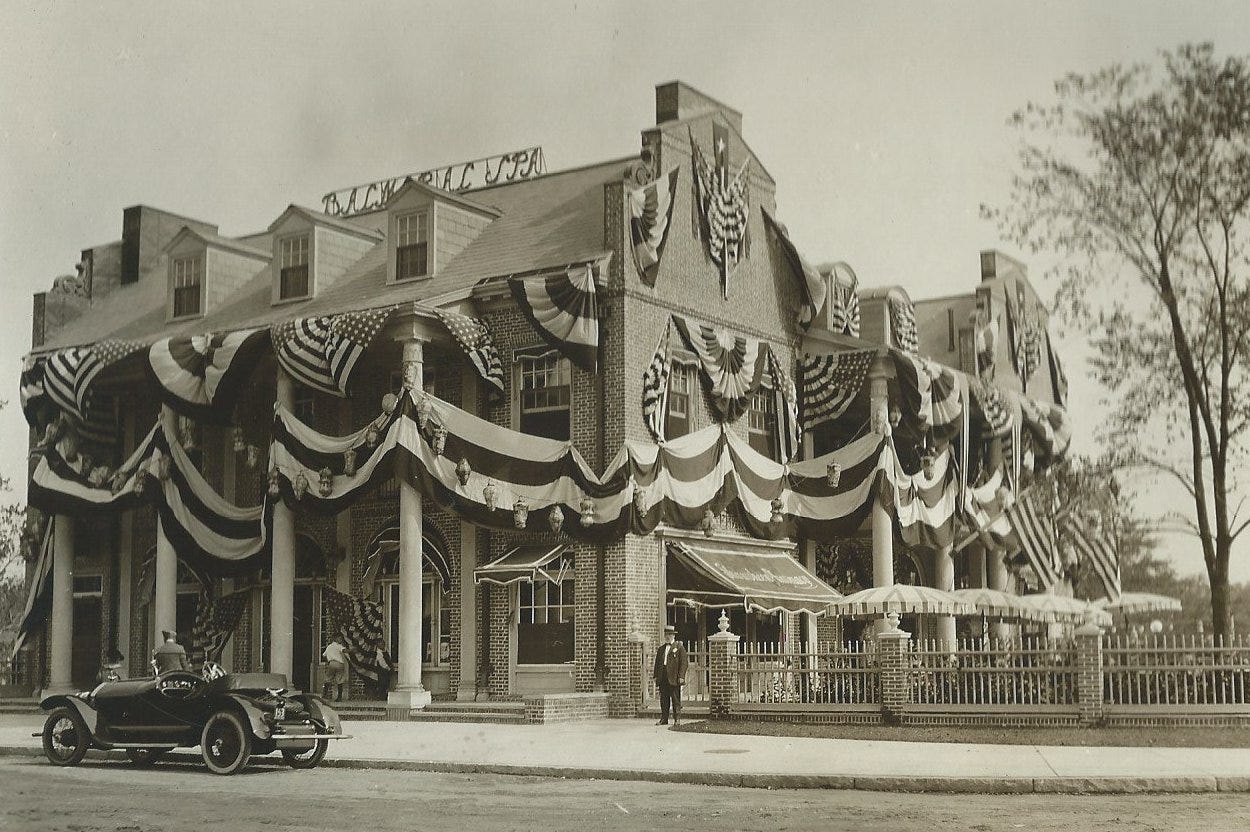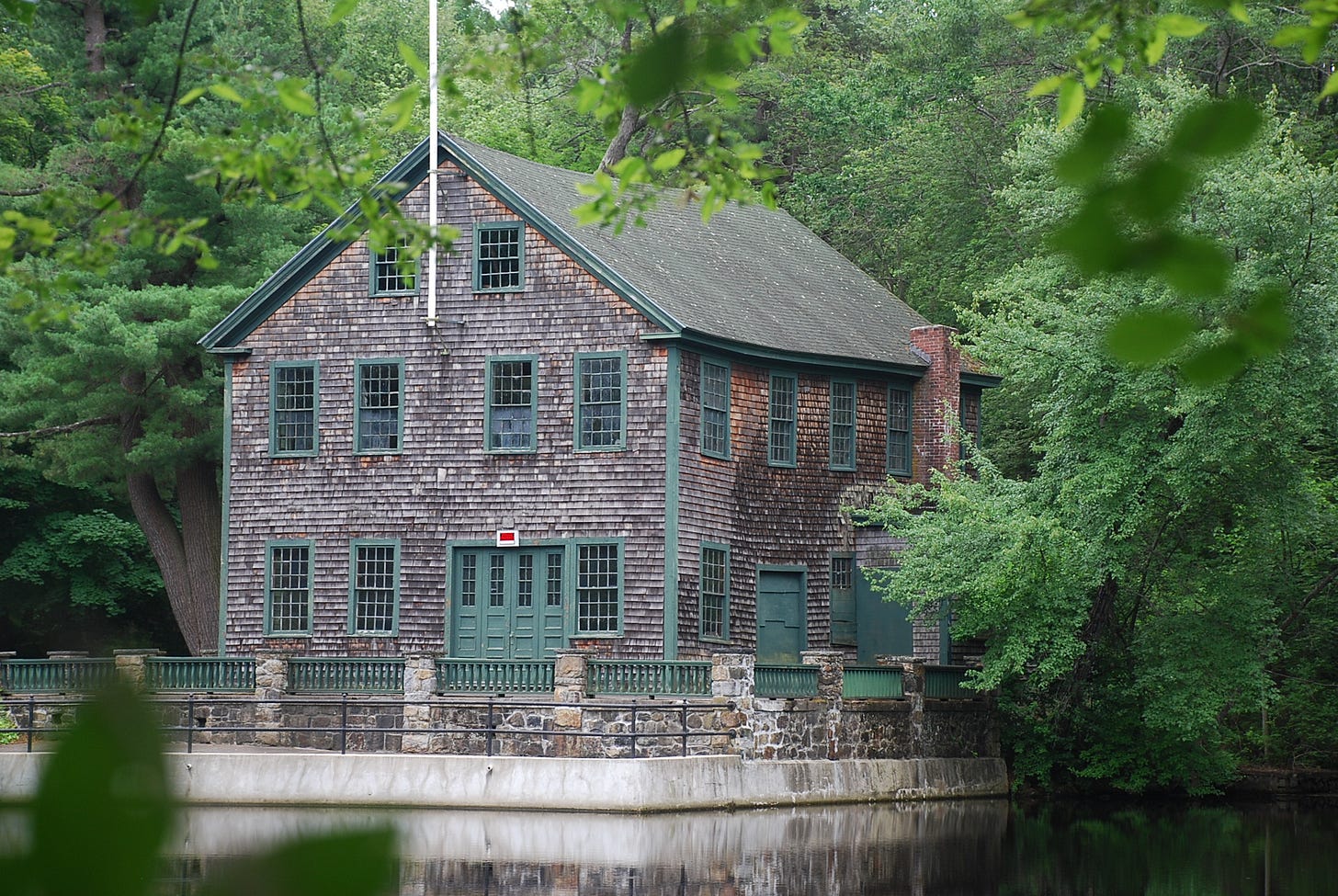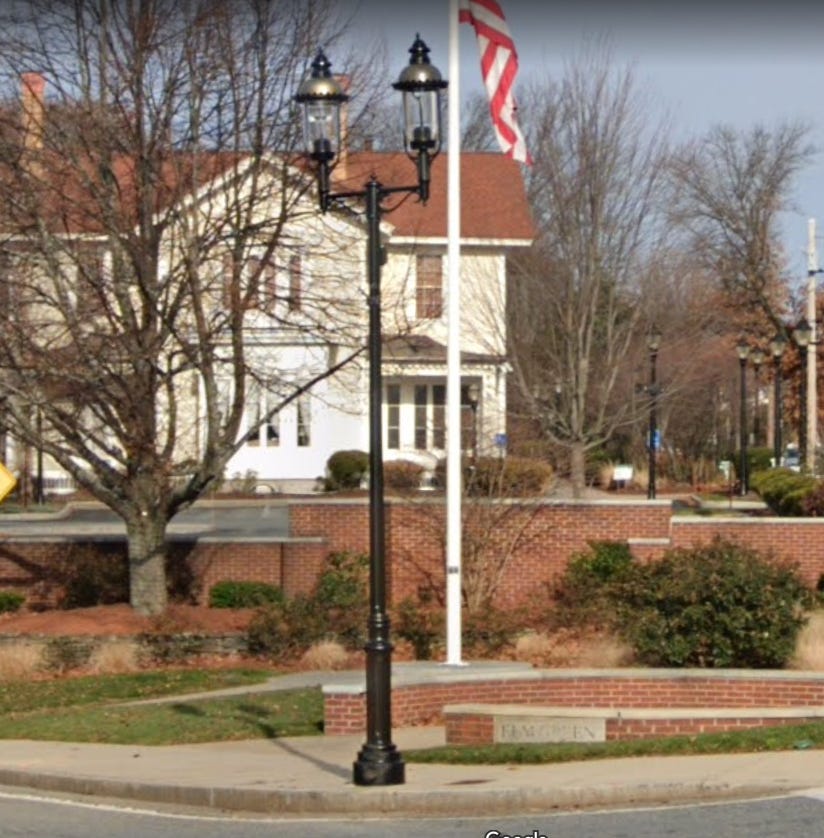Many thanks to History Buzz Guest Writer Barbara Bunn for writing today’s post!
Have you ever participated in the Feaster Five Road Race in Andover, MA or maybe you are planning on participating this year either as a runner, walker or an observer. Are you curious about the buildings you passed along the route?
This article will highlight a few of the historical landmarks that are along the 5 kilometer and 8-kilometer course and are part of the history of Andover. To make sure you have the whole route in time for Thanksgiving, we’ll post this article in two parts. Today’s article will take you all along Main Street. Tomorrow, we’ll pick up the race as it turns onto Morton Street.
North Main Street
The starting point of the Feaster Five Road Race is in Shawsheen Village, listed on the National Register of Historic Places. Before it was Shawsheen it was Frye Village where Samuel Frye, descendant from the one of the original founders of Andover, built a saw and grist mill in 1718 on the banks of the Shawsheen River. In 1824 John Smith, an immigrant from Scotland, opened a factory on the Shawsheen River to build machinery used in cotton manufacturing. In 1836 John Smith, his brother Peter, and a friend John Dove opened a flax mill on the Shawsheen River. This business was very successful and in 1843 they moved their business to Abbott Village. William Wood moved to Andover in 1891 with the dream of creating a planned community for his American Woolen Company. William Wood developed Shawsheen Village from 1918 to 1923.
As you start your journey up North Main Street, you will see many buildings that are connected to William Wood.
303-305 North Main Street Balmoral Spa
This office building was built by William Wood in 1921. It was the location of a pharmacy, shops, and restaurant, with a meeting hall on the top floor used for lectures and dances. Outside there was a polished cement floor for outdoor dancing as well as tennis courts, a bowling green and playing fields. There was also a place to launch canoes.
278 North Main Street
At this location was William Poor’s blacksmith and wagon company built about 1833. It was at one time considered the premier wagon shops in the Merrimack Valley. William Wood purchased this building in 1899 and moved it. The building was known as the Arden Casino and it was used by the Wood family to entertain guests. Plays and dances were held here. The wagon company was located approximately where the Christian Science Church is located today.
276 North Main Street
The original owner of this lovely home was John Dove from the Smith and Dove Manufacturing Company. William Wood purchased this home in 1891, called it Arden after the magical forest from the Shakespeare play “As You Like It” and made many improvements
260 North Main Street
This home was built by William Wood for his oldest son William Jr. The home is now owned by the LANAM Club which is a social club for businesses of Greater Lawrence. Membership comes from Lawrence, Andover, North Andover and Methuen. Although this house cannot be seen from the street, the driveway hints at a beautiful home.
209 North Main Street
This property is known as the Shawsheen Plaza. Before it was the plaza it was a farm owned by Fannie and Frank Golden. Albert Schlott purchased the farm and additional acres for a total of 30 acres and started to plan a shopping center Elm Farm Super Market and Supreme Cleaners were the first stores to open in 1959. These stores were followed by Woolworth’s, Liggett’s Drug Store, Hilda’s Hair Stylist and Endicott-Johnson Shoe store just to name a few. In an article that Gail Ralston wrote for the Andover Townsman, she describes how the Elm Farms Store would roll your groceries outside. You would get a claim ticket, pull your car up to the store and your groceries would be loaded into your car!!
188-222 North Main Street
These homes were built for the workers at the Marland Mills
Please note that at this intersection the participants in the 5K race will take a left turn onto High Street and will merge later with the 8K runners.
1 North Main Street
Elm Green Veterans Memorial Park is at the intersection of Main Street, High Street and Elm Street and honors all Andover men and women who served their country. The green was originally dedicated in 1920 and was rededicated in 1995.
2 North Main Street
Memorial Hall Library which was dedicated in 1873 to Andover’s Civil War heroes. The second floor has a Civil War Memorial Room and meeting hall. The library was created in 1870 as a result of donations from John and Peter Smith and John Dove from the Smith and Dove Manufacturing Company, as well as contributions from the citizens of Andover.
2 Elm Square, The Musgrove Building
This building was built in 1894-95 by John H. Flint who was a successful business man in real estate and the stock market. He was president of the Tyer Rubber Company from 1878 to 1882. The building was named for Sir John Musgrove, an uncle of Henry G. Tyer the founder of the Tyer Rubber Co. and Great Uncle of Frances Tyer Flint who was the wife of John H. Flint. The Musgrove Building has been the location of many different tenants who leased space there.
10-16 Main Street
The Barnard Block was developed by father and son Henry and Jacob Barnard. This block has been home to many different businesses over the years including Ford’s Coffee Shop. This building is listed on the National Register of Historic Places.
20 Main Street
Andover Town House was built in 1858 to meet the needs of the town that had just separated from North Andover. The town needed a place to do business and to hold town meetings. In 1982 the town offices were moved to Bartlet Street and in 1989 this building was restored and is used for many different functions.
23 Main Street
This is the site of the Andover National Bank built in 1890. The Masons occupied the third floor, the Merrimack Fire Insurance Company was located on the second floor. The bank shared the first floor with a drugstore and the Andover Savings Bank. In 1982 this building was listed on the National Register of Historic Places.
65 Main Street
This lot of land was once owned by the Rev. Justin Edwards who lived in a house on the site of the former post office building at 71 Main St. Through the years this lot had a few different owners including at one point William Wood. It was an empty lot until the Gulf Oil Corporation of Pennsylvania purchased it in 1936. Although there have been several different owners of the business, the property has remained a Gulf Station since 1936.
71 Main Street
This building was the former site of the Andover Post Office. There have been several locations of the central post office since the formation of the postal service in 1789. Actually this site was the 9th location of the Post Office. In 1989 the Post office moved for the 10th time to Stevens Street.
97 Main Street (our house!)
Amos Blanchard built this house in 1819. It was in the center of a farm surrounded by an apple orchard, vegetable garden, grape vines and hay fields. Amos Blanchard was a South Church Deacon and a cashier at the Andover Bank. The Blanchards also took in boarders who attended Phillips Academy. Since 1929, the Andover Center for History and Culture has called it home. The Blanchard House is on the National Register of Historic Places.
111 Main Street
This home was built by Major Daniel Cummings in 1819. James Locke purchased this home in 1824, and it became Locke’s Tavern. The tavern became a meeting place for members of the community to discuss ideas including the development of the Andover-Wilmington Railroad.
125-127 Main St
At this location there has been a school, a restaurant, a barbershop, and a soap factory. However, since 1930 it has been the home of the clothing store, The Andover Shop.
134 Main St
In 1819 Amos Blanchard purchased this lot and then sold it to John Brown, a carpenter. Over the following years, many different families owned this home before it was sold in 1967 to the Andover Committee for a Better Chance and it became the ABC House "A Better Chance Inc." ABC refurbished it as a dormitory, with quarters for resident director's family. This organization is aimed at offering qualified minority students the same educational opportunities and academic future as students have in an affluent suburb with high educational standards. The program was established through Dartmouth College, and Andover was one of the first communities to adopt the program. The students live here and attend Andover High School, taking part in school and community affairs with host families.
Here, the Feaster Five route turns left onto Morton Street. We’ll pick up the race route there tomorrow. Stay tuned!
Thanks for reading!
Barbara & Elaine
Resources
Andover Center for History and Culture (Andover Historical Society)
The Townswoman’s Andover by Bessie Goldsmith
Andover Veterans Memorial Walking Tour
Andover Stories Volume 1, Gail Ralston, editor
Andover -What It Was What It Is - a book published in 1946 by the Andover Townsman on the 300th anniversary of the town.
Andover A Century of Change 1896-1996 by Eleanor Richardson

















